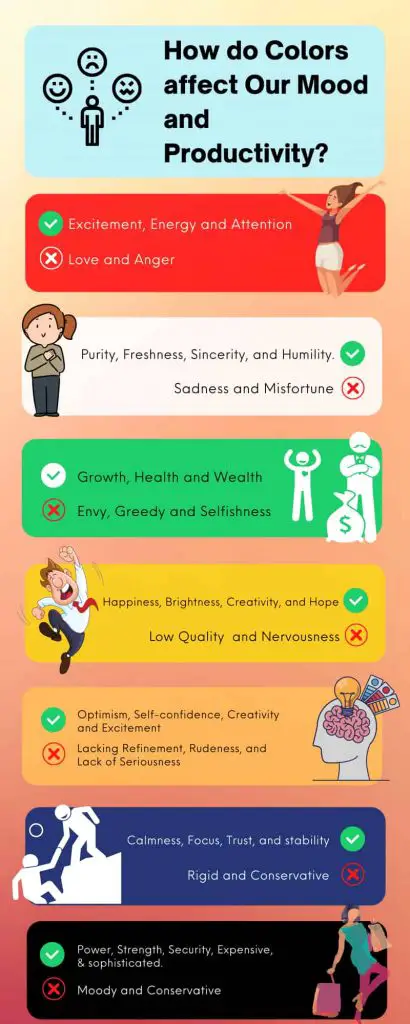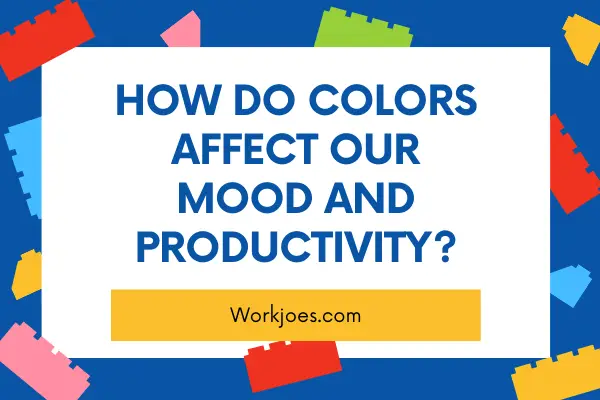Did you know you can increase productivity and bring more positivity to your work by simply employing certain colors in your office space?
As the Workplace is becoming more and more competitive, Corporate companies are looking for ways to increase productivity. Colors can play a big role in affecting mood and emotions.
With so many color combinations available it is a daunting task to ascertain which ones will help keep your employees motivated at work.
Yes, colors do have certain effects on our mood, actions, and even how we feel. Various researches show how different colors affect our mood and productivity at work. Some colors increase positivity while some other colors can have more of a negative impact.
Read on to learn more about colors and their effects.
How do Colors affect our mood at Work?
Color is an important factor when it comes to mood and productivity at work. When you use colors that are strongly associated with those feelings, you can help boost the mood of your employees.
Different colors produce different emotions so it is essential to know which colors will make your employee happy and productive at work.
Right Colors are a great way to improve moods and reduce anxiety and stress. But how do you decide which color combinations will improve the performance and productivity?
We have got a Handy Infographic with different color combinations to boost productivity at work. A total of 7 colors which is most widely used in interiors especially Office interiors. The Upside and downsides of each color have been listed in the infographic.
How do Different Colors affect your mood? Different types of Color Schemes and their impact on Productivity.

What is Color Psychology?
Color psychology is the study of colors and their influence on human behavior. It has been researched by scientists and psychologists that colors influence our thoughts and emotions and they can be used to our advantage.
However, color influence may differ from individual to individual depending on various factors such as age, gender, culture, situation, etc.
Because everyone doesn’t perceive colors in the same way. For example, the color white is perceived as purity and cleanliness in some parts of the world while in some others it is used as a symbol of mourning.
So one should not ignore the fact that color impact may differ from person to person and place to place.
Importance of Color Psychology in Workspace
A recent study by the University of Sydney found that colors affect our mood and productivity at work. It’s important to understand how this phenomenon can affect us so we can make better choices about what colors we wear, paint our office with, and where we spend time.
Humans are visual creatures and different colors affect our purchase decisions.
Understanding colors and their effects are very essential. It plays a vital role in stimulating actions towards desired goals and objectives.
Certain colors boost our mood and energy which can be used to enhance efficiency resulting in increased productivity. Similarly, you should avoid such colors which build stress and pressure.
While working you have to sit in the same place for long hours which involves many important and serious tasks. It also requires your ability for creative thinking and decision-making.
So choosing the right color for your office space becomes very crucial. Not only office but it can be any place where you work such as your home office and even your living room.
The Psychology Behind Colors
So now you have a fair idea of how colors affect human behavior, mood, and emotions. You have understood why it is important to choose colors wisely for your workspace. Now it is time to learn about the meaning of the colors.
Some of them are associated with nature while some with culture. But there is more than one meaning of each color.
So one single color can represent both good and bad. Let’s have a look –
RED – Red color represents excitement, energy, and attention. It motivates us to take speedy action.
But remember red is also associated with the strongest emotions i.e. love and anger.
WHITE – White is the color of purity and freshness. It is also associated with sincerity and humility.
Again in some parts of the world white also reflects sadness and misfortune.
GREEN – Green is the hue of nature. It symbolizes growth, health, and wealth.
But a very dark green also represents envy, greedy, and selfishness.
YELLOW – Yellow symbolizes happiness, brightness, creativity, and hope.
But sometimes yellow may look low quality and too much of the color may also lead to nervousness.
ORANGE – Orange is the color of optimism, self-confidence, and excitement. It makes us more creative in thinking. But the downsides of the Color orange are Lack of Refinement, Lack of seriousness, and Rudeness.
BLUE – Blue is associated with calmness and focus. It also represents trust and stability.
While sometimes navy blue may look rigid and conservative.
BLACK – Black represents power, strength, and security. It looks expensive and sophisticated.
Sometimes black can also be moody and conservative.
Bottom Line
Though studies have established a connection between color and human behavior yet more scientific research is needed to get a better understanding of color psychology.
People perceive color differently because of personal and cultural factors. So the effects of these colors will always differ depending on the same factors.
But no matter what incorporating the right colors artfully can help a lot in improving your efficiency, focus, and productivity. You do not need to paint the entire office wall with one color for this.
Try to combine some colors that both meet your need as well as make your office look beautiful.
If we have missed anything to mention, please add them in the comment box below. We would love to know your thoughts on color psychology and if you loved this post then do share it with your friends and family. See you in the next post.
Keep visiting Workjoes for more information on Work From Home, Business, Workplace, Career, Office Decor, and Online Courses.





